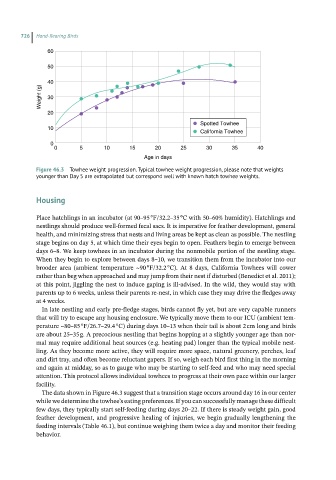Page 724 - Hand rearing birds second
P. 724
726 Hand-Rearing Birds
60
50
40
Weight (g) 30
20
Spotted Towhee
10
California Towhee
0
0 5 10 15 20 25 30 35 40
Age in days
Figure 46.3 Towhee weight progression. Typical towhee weight progression, please note that weights
younger than Day 5 are extrapolated but correspond well with known hatch towhee weights.
Housing
Place hatchlings in an incubator (at 90–95 °F/32.2–35 °C with 50–60% humidity). Hatchlings and
nestlings should produce well‐formed fecal sacs. It is imperative for feather development, general
health, and minimizing stress that nests and living areas be kept as clean as possible. The nestling
stage begins on day 5, at which time their eyes begin to open. Feathers begin to emerge between
days 6–8. We keep towhees in an incubator during the nonmobile portion of the nestling stage.
When they begin to explore between days 8–10, we transition them from the incubator into our
brooder area (ambient temperature ~90 °F/32.2 °C). At 8 days, California Towhees will cower
rather than beg when approached and may jump from their nest if disturbed (Benedict et al. 2011);
at this point, jiggling the nest to induce gaping is ill‐advised. In the wild, they would stay with
parents up to 6 weeks, unless their parents re‐nest, in which case they may drive the fledges away
at 4 weeks.
In late nestling and early pre‐fledge stages, birds cannot fly yet, but are very capable runners
that will try to escape any housing enclosure. We typically move them to our ICU (ambient tem-
perature ~80–85 °F/26.7–29.4 °C) during days 10–13 when their tail is about 2 cm long and birds
are about 25–35 g. A precocious nestling that begins hopping at a slightly younger age than nor-
mal may require additional heat sources (e.g. heating pad) longer than the typical mobile nest-
ling. As they become more active, they will require more space, natural greenery, perches, leaf
and dirt tray, and often become reluctant gapers. If so, weigh each bird first thing in the morning
and again at midday, so as to gauge who may be starting to self‐feed and who may need special
attention. This protocol allows individual towhees to progress at their own pace within our larger
facility.
The data shown in Figure 46.3 suggest that a transition stage occurs around day 16 in our center
while we determine the towhee’s eating preferences. If you can successfully manage these difficult
few days, they typically start self‐feeding during days 20–22. If there is steady weight gain, good
feather development, and progressive healing of injuries, we begin gradually lengthening the
feeding intervals (Table 46.1), but continue weighing them twice a day and monitor their feeding
behavior.

